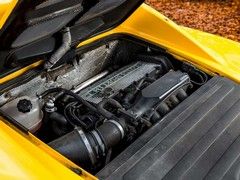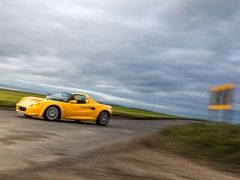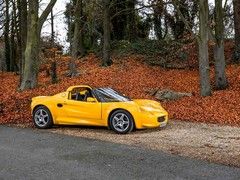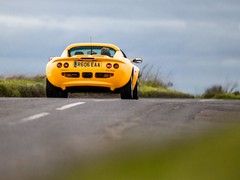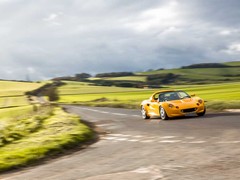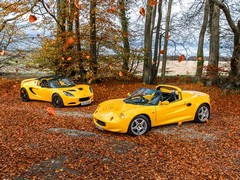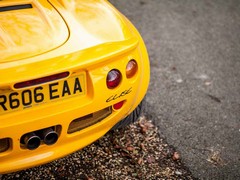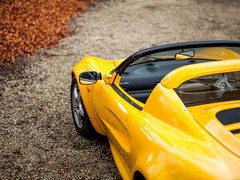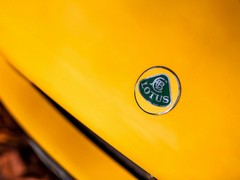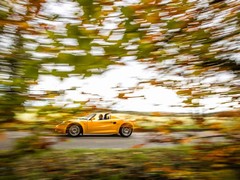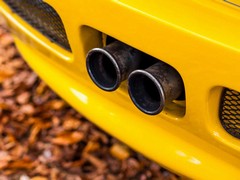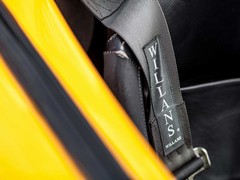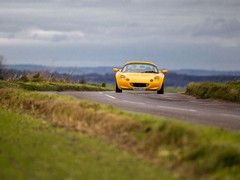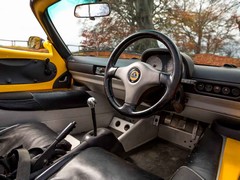Lotus Elise at 20: PH Heroes
Why 20 years on the Elise remains one of the best handling cars on the planet

Then things started to get blurry. First to join the classic nexus were older mainstream cars, the sort previously regarded as life-expired bangers, which acquired enough retro kitsch to be grudgingly admitted. Then the time envelope started to slip as more modern models found themselves being described - often by those trying to sell them - as future classics. Finally we got to the full temporal displacement; the idea that some cars, like Bulgarian wine, are able to completely bypass the ageing process, instantly acquiring classic status the moment they are downloaded from their designer's CAD terminal.
You could spend at least three lifetimes arguing about definitions here, and drain the Internet of pixels while doing so. But the Lotus Elise is one of very few that can lay genuine claim to being one of these unicorn grade always-classics, the most radical sports car of its generation, and one that was timeless from the day it was introduced two decades ago.
That's right, its 20 years since the Elise first appeared, a fact that makes many of us feel old. It had its official debut at the Frankfurt motor show in 1995 and deliveries started in 1996, so it's on the cusp of its third decade. Prepare for a deluge of backward-looking articles - we've tried to beat the rush. But in the Elise's case, the hype is mostly justified.
Lots of trouble
I'll spare you most of the soap opera, but by the mid-1990s Lotus was in a semi-permanent state of crisis. The ageing Esprit was being produced in ever smaller numbers, an expensively developed V8 engine doing little to sharpen its case. The front-driven 'M100' Elan had been a huge hit with critics when it launched in 1989, but after a couple of years of decent sales (and an 'S2' refresh) its star had waned against cheaper rivals like the Mazda MX-5. In 1993, when GM sold its controlling stake in the company, Lotus produced just 320 cars; something that puts its more recent problems into perspective.
The new owner was Romano Artioli, a self-made Italian who wore the adjective 'controversial' as closely as one of his expensive suits. He was the man behind the relaunch of the Bugatti brand and the megabucks EB110 supercar, the slow sales of which were forcing Bugatti into a messy bankruptcy during the same period. So he was predictably keen to offload the British sports car maker, eventually persuading DRB-Hicom to buy most of his stake in 1996. Yet to give him his due, he was the man who agreed to spend the cash necessary to develop the Elise during his brief time in charge. He got to name it, too - after his granddaughter, Elisa.
The Elise was nothing short of an adrenaline shot for the beleaguered Lotus, and pretty much the most radical thing in sports cars since the original Seven. A small development team had relocated mountains, creating it around an innovative lightweight bonded aluminium chassis (which Lotus had been working on for years) and elegant glassfibre bodywork designed by Julian Thomson, the look clearly paying homage to the sportscar racers of the 1960s and 1970s. Like most of its predecessors it was powered by relatively cheap mechanical components, in this case the fizzy 118hp 1.8-litre Rover K Series, mid-mounted transversely and driving the rear wheels. The original plan had been to make it even more hardcore - the roof and doors arrived after development had begun - but even with such luxuries in place the Elise tipped the scales at just 723kg, giving a power-to-weight ratio slightly better than that of the then-new Porsche Boxster.
In short, it was a brilliant reinterpretation of all the values that had made Lotus great; it was light, responsive, handsome and enticingly affordable. Early roadtests were almost radioactive in their praise and excitement levels spiked to the low stratosphere after prices were announced - for £18,950 the Elise undercut every obvious rival; a second-gen Toyota MR-2 was £22,000, the roofless and heater-less Renault Sport Spider was £26,600 and a Porsche Boxster was £33,950. Lotus had hoped to sell 800 Elises a year; by the end of 1996 it had built 2,500 and had a growing waiting list.
Let's do the timewarp
Which brings us directly to here, and one of those early Elises. The cars we choose for Heroes shoots tend to be the nicest we can find, in many cases examples that are still close to the condition they were in when they left the factory. This early Series 1 definitely isn't that, but we could not have found a better car for the story.
Because owner Adrian Thomson is the only name there's ever been on the registration document, having collected his car on the August 1 1997 - he waited for the 'R' registration plate. It spent most of that time as a daily driver and - with the help of longer road trips and regular track use - it's racked up a very impressive 136,000 miles, while benefiting from various sympathetic upgrades along the way. It's got the knocks and wear that you would expect from anything of its age and mileage, but it's a patina that it wears with enormous pride.
Getting in is a time machine moment as the S1's interior feels instantly familiar, like going back to your childhood bedroom would. It's a good 10 years since I last sat in an Elise of this vintage, but everything is as I remember- the clear Stack instruments, the bulbous gear lever right where it should be, the fat sill dictating a slightly offset driving position. Even the parts bin switchgear feels right, the Peugeot light buttons and Cavalier column stalks. Alright, so I'd forgotten that the window winders and mirrors were donated by a Metro; but it's a bigger shock to realise something that still feels as modern as the Elise actually overlapped with the last couple of years of what was, by then, the wholly unloved Rover 100.
I pick the car up the car from Thomson's house in Winchester and head north to the roads around Lambourn in Berkshire for some autumnal colour, meaning a 40-mile schlep along the A34 and M4. Thomson isn't a huge believer in roofs and, as the Elise lives in his garage, it normally stays topless. Unfortunately it's starting to rain as I set out, but as the roof has picked up some damage it stays in the boot and I trust to the combination of speed and the windscreen to stay dry. "Don't worry," Thomson assures me, as he waves me off in his pride and joy, "it doesn't matter if the interior gets wet." Top bloke.
Thomson's updates over the years have included a more powerful Sport 135 engine, sports suspension, a close ratio gearbox, a sports exhaust and four-point harnesses for regular track work. None of which stop the driving experience from feeling as familiar as the slightly worn cockpit, from the immediacy of the throttle response and the mind-reading steering to the way grit and small stones rattle their way across the metal floor every time you go around a corner. The revised gearing isn't too low for cruising and the heater blows hot enough to keep the cabin toasty, even without a roof. Usability has always been a core part of the Elise's appeal; a car you can drive without ever having to wear rubber trousers.
Twice as nice
In Lambourn I meet up with snapper Tim Brown and Peter Wright, the owner of a nearly new Elise 20th Anniversary that - in evidence of either remarkably good luck or Editor Trent's remarkable planning abilities - is finished in pretty much exactly the same shade of yellow. We're planning to follow up with a more detailed comparison story with both cars, but the fundamental similarities despite the two decades that separate them are striking.
The S1 can't match the straight line pace delivered by the 20th Anniversary's supercharged Toyota engine, but it still feels plenty fast enough thanks to the K Series' raucous enthusiasm, as voiced and amplified by the rorty exhaust. The ride is pliant, even on the local tarmac that West Berkshire council seems to be leaving to return to nature. The steering remains sublime: unassisted, bristling with feedback and so dialled into the road that you really can feel minor changes in camber or even surface texture. If anybody ever asks you to explain steering feel then save your breath and just sit them in an Elise for five minutes.
Even driving at a pace that's suitably respectful of somebody else's favourite car the Elise S1 feels special. The agility and response effectively disguises the fact there isn't a huge amount of grip by modern standards, even on a decent set of Toyos. There doesn't need to be; everything is flagged better than a semaphore school. This remains one of those cars you can drive hard, legally and socially acceptably, all at the same time.
Want one
I'm not going to end by asking where progress has come in the last 20 years, because that's obvious. It's in all the things that the S1 Elise didn't have - the current one is still minimalist by modern standards but even airbags, air-con and stability control now feature. It's also come in the way that while cars have got faster pretty much across the board, they also feel far less well connected. Dynamically the Elise has aged only in that, two decades on, it feels even more involving than practically everything else on the road. To throw objectivity under the bus on this one, it's close to being unimproveable, and that's what makes it more of a classic than 90 per cent of the cars that description gets stuck to. I drive back to Winchester having practically convinced myself I need to buy one, but knowing that Thomson will never sell me his.
LOTUS ELISE S1
Engine: 1,796cc four-cylinder
Transmission: 5-speed manual, rear-wheel drive
Power (hp): 118@5,500rpm
Torque (lb ft): 122@3,000rpm
0-62mph: 5.9sec (claimed)
Top speed: 126 mph
Weight: 723kg
On sale: 1996-2000 (replaced by S2)
Price new: £18,950
Price now: £8,500-£15,000
Elise-owning PHers on why they love their Lotuses - full story here!
Photos: Tim Brown
Gassing Station | General Gassing | Top of Page | What's New | My Stuff



